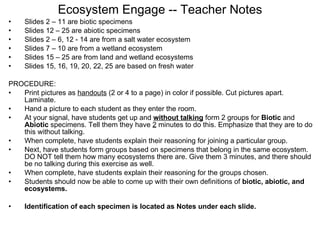Ecosystem engage biotic abiotic
- 1. Ecosystem Engage -- Teacher Notes ║▌║▌▀Żs 2 ©C 11 are biotic specimens ║▌║▌▀Żs 12 ©C 25 are abiotic specimens ║▌║▌▀Żs 2 ©C 6, 12 - 14 are from a salt water ecosystem ║▌║▌▀Żs 7 ©C 10 are from a wetland ecosystem ║▌║▌▀Żs 15 ©C 25 are from land and wetland ecosystems ║▌║▌▀Żs 15, 16, 19, 20, 22, 25 are based on fresh water PROCEDURE: Print pictures as handouts (2 or 4 to a page) in color if possible. Cut pictures apart. Laminate. Hand a picture to each student as they enter the room. At your signal, have students get up and without talking form 2 groups for Biotic and Abiotic specimens. Tell them they have 2 minutes to do this. Emphasize that they are to do this without talking. When complete, have students explain their reasoning for joining a particular group. Next, have students form groups based on specimens that belong in the same ecosystem. DO NOT tell them how many ecosystems there are. Give them 3 minutes, and there should be no talking during this exercise as well. When complete, have students explain their reasoning for the groups chosen. Students should now be able to come up with their own definitions of biotic, abiotic, and ecosystems. Identification of each specimen is located as Notes under each slide.
- 2. ?
- 3. ?
- 4. ?
- 5. ?
- 6. ?
- 7. ?
- 8. ?
- 9. ?
- 10. ?
- 11. ?
- 12. ?
- 13. ?
- 14. ?
- 15. ?
- 16. ?
- 17. ?
- 18. ?
- 19. ?
- 20. ?
- 21. ?
- 22. ?
- 23. ?
- 24. ?
- 25. ?
Editor's Notes
- Sea kelp ©C biotic, saltwater, plant
- Sea anemone ©C biotic, saltwater, animal
- King crab ©C biotic, salt water, animal
- Coral ©C biotic, salt water, animal
- Clam ©C biotic, salt water, animal
- Dragonfly ©C biotic, wetland, animal
- Great egret ©C biotic, wetland, animal
- Turtle ©C biotic, wetland, turtle
- Duck eggs ©C biotic, wetland, animal
- Dandelion ©C biotic, land, plant
- Methane flume ©C abiotic, salt water, gas and rock
- Deep sea vent ©C abiotic, salt water, rock
- Undersea rocks ©C abiotic, salt water, rocks
- Vapor ©C abiotic, land, factory smoke
- Iceberg ©C abiotic, fresh water floating in salt water
- Tower rocks ©C abiotic, land, desert
- Volcano ©C abiotic, land
- Morning Glory Pool ©C abiotic, land, fresh water thermal pool
- Wine glass rock formation ©C abiotic, land carved by water
- Amethyst geode ©C abiotic, land, rock
- Waterfall ©C abiotic, freshwater
- Quartz crystals ©C abiotic, land, rock
- Rock arch ©C abiotic, land rock
- Clouds ©C abiotic, water vapor

























